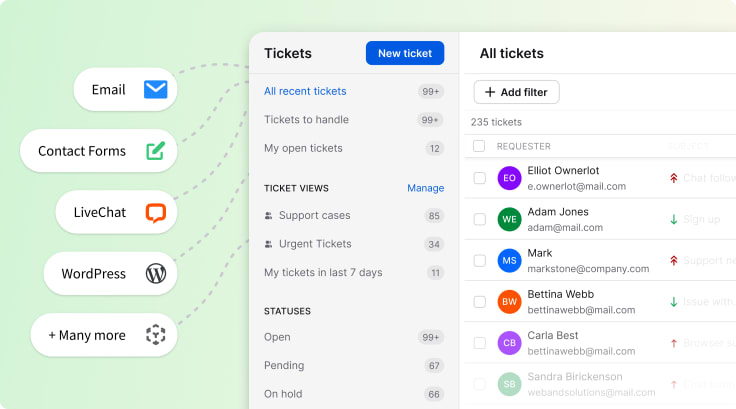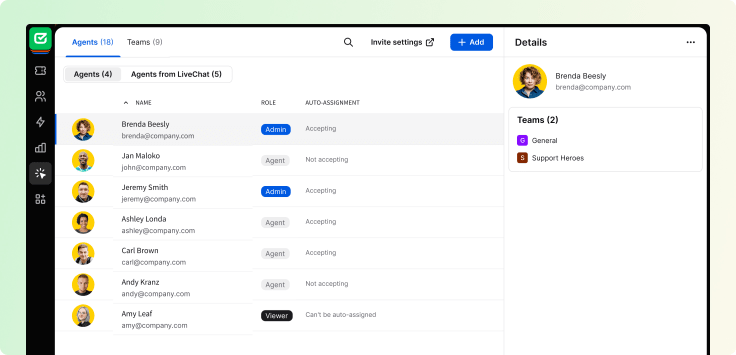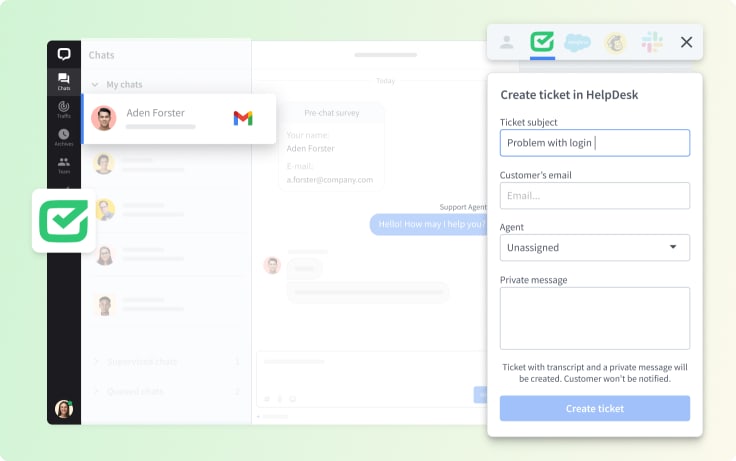The IT department is the glue that holds an organization together. Everyone, from employees to customers to suppliers to even management, needs access to IT resources to interact with and access essential digital services and fix software issues.
With quick, uninterrupted, and seamless access to IT, these users could perform their roles properly, which would ultimately negatively affect the entire organization.
Service desks play a massive role in the effective distribution of IT resources. While team members can communicate with each other through a team inbox, service desks act as a hub for employees, customers, and management. Helping them navigate the incredibly complex and intricate IT environment.
Introduction to service desks
A service desk is a single point of contact between an organization and its employees, customers, stakeholders, and partners. As mentioned, it’s a hub for all service requests, including technical issues and system outages, and helps users connect with teams and departments.
In terms of helping customers, service desks, like help desks, improve customer satisfaction by delivering services tailored to their expectations. Service desks handle everything from helping resolve routine computer crashes and other incidents to tracking and managing IT assets to ensure they’re used efficiently and regularly. As a side benefit, this management of IT resources reduces overall support costs and saves valuable company time.

Service desk processes
An IT service desk is usually divided into many processes that handle specific types of users and problems. These processes help streamline service desk operations and improve customer service.
Some of the most important processes of a service desk include:
-
Incident management: Service desks help resolve incidents related to technological errors and failures like an employee’s computer crashing.
-
Problem management: Service desks utilize AI or built-in algorithms to identify recurring problems and find permanent solutions to prevent future errors.
-
Service request management: It’s all about processing user requests, such as software installations, inserting new hardware, or setting up new user accounts.
-
Change management: A service desk receives requests from all types of users regarding changes to an organization’s IT systems, services, and infrastructure. It uses a ticketing system to separate requests regarding urgency and usefulness and ensures that the approved changes are made slowly.
Service desk software
Service desk software acts as the front end of the service desk, where users can log in with their requests, incidents, and problems. It provides a centralized platform for service desk operations, including ticketing, knowledge management, and self-service.
Service desk software can also integrate with other IT service management system components, including help desks and other IT tools, such as configuration management databases and asset management systems.

Benefits of service desks
Service desks are quite underrated because many companies need to recognize how much time and resources they can save if adequately implemented to serve all users. If the implementation goes smoothly, here are four legitimate benefits of service desks you might have yet to learn.
Customer satisfaction
One of the most important benefits of service desks is their ability to improve satisfaction through responsive and timely IT support. For example, imagine a customer with IT issues who logs them into a ticket.
According to the handbook, a service desk will serve that ticket promptly, reducing downtime and customer frustration.
It also helps that a service desk gives customers a single point of contact for all their IT-related inquiries and issues, saving them from having to hop from department to department.
Reduces downtime
Services desks are designed to handle service requests and incidents much quicker than humans. It means less time is spent waiting for an IT issue to be resolved. Furthermore, some service desks have monitoring tools to detect and eliminate anomalies before they become significant problems.

Reduces costs
Service desks have built-in functions like ticket prioritization and automated routing to ensure that the most critical issues are serviced first and that the right personnel is working on the right job. This, in turn, helps the system optimize IT resources, streamline IT support processes, and improve overall efficiency, allowing the company to reduce costs.
Provide valuable insights
The best service desks learn from every interaction and incident, collecting data that can provide valuable insights to improve business processes and IT efficiency. For example, a service desk can analyze the pattern, frequency, and types of incidents to detect recurring problems that disrupt business operations.
Join our free 14-day trial and see how the HelpDesk service desk can help you streamline your business processes. 🚀
Service management
People often get confused about the difference between service desks and service management, so we’d clarify it once and for all. Service management manages customer IT services, including design, creation, delivery, and support.
It does have some overlapping processes with service desks, like problem management and change management, but service management is more comprehensive than just the technical components of these services.
Instead, it encompasses all activities involved in delivering IT to the business’ customers to meet the organization’s needs. Effective service management is key to improving satisfaction and increasing business efficiency.
Key features of a service desk
A service desk is designed to be the single point of communication between service providers and employees, customers, and business partners. As the name suggests, its primary function is to handle service requests and incidents and manage communication with all users.
Service desks add value by enhancing the end-user experience. It’s about solving immediate tech issues, facilitating change, and ensuring continuity. To do that, service desks rely on several key features:
User-friendly interface
A service desk can only be integral to managing the company’s IT resources if it’s easily accessible and easy to navigate. However, a user-friendly interface is necessary to ensure users can easily access and send service requests and incident reports.
The faster users send these requests, the faster a service desk can promptly attend to them and allocate resources.

Knowledge base
A service desk’s knowledge base usually includes many articles, FAQs, and troubleshooting guides. These contain information about known errors and joint issues and their step-by-step solutions.
It allows users to fix minor problems, saving a company’s IT resources and costs and reducing downtime. As time passes, the knowledge base will expand, which may prompt companies to encourage ongoing learning about minor issues through the knowledge base.

Self-service portal
A user-friendly service portal lets users log in to their incident reports and service requests. Once logged in, the user can track these requests and the attached tickets to estimate how long it will take for the system to service them.
Some self-service portals also allow access to the service desk’s built-in knowledge base, allowing users to help themselves if their request takes too long. This way, users don’t have to constantly interact with support staff for updates on their requests, leading to faster problem resolution.
Reporting and analytics
Every IT system needs analytics to evaluate its operating performance, and service desks are no different. Most service desk software has a built-in reporting system that provides detailed analytics on key performance metrics such as user satisfaction, ticket volume, service delivery speed, and agent performance.
Collecting and storing data according to these metrics helps provide insights that the IT team can use to improve service quality, monitor performance, and recognize system bottlenecks. Over time, these insights could also help the team adjust resource allocation and plan for the future based on what the data tells them.
The easiest help desk system for a team like yours
Discover HelpDesk
Integrations
Most service desk software includes multiple integration options to enhance its capabilities, develop more streamlined workflows, and improve efficiency and user experiences.
Integration with customer relationship management (CRM) systems like Hubspot and Zoho CRM helps service desk agents access customer data, track their interactions with the support team, and understand a customer’s history.
Integration with monitoring and alerting tools like Nagios or Zabbix allows real-time system monitoring. It will enable the support staff to respond to incidents proactively before users report them. There are several other integration examples, but the two mentioned above are the most important in maximizing customer satisfaction.
Get the best of both worlds with the HelpDesk and LiveChat integrations. 💻 Take care of your customer in real time and in your time. 🔥

Artificial intelligence and AIOps
The introduction of artificial intelligence (AI) in service desks has made these systems more efficient, proactive, and intelligent in handling IT service management. It has helped automate repetitive tasks, enhance decision-making, and improve incident response rates.
Let’s take an even closer look at how AI technologies leverage natural language processing (NLP) and machine learning (ML) to improve service desk operations.
Automated ticketing and incident management
AI can streamline the regular ticketing system by applying priorities and categories to various service desk tickets. The NLP algorithms can analyze each ticket’s description and categorize it based on how urgently the content needs to be serviced.
This process helps triage all incidents, allowing the support staff to handle the most critical service requests first while lowering the possibility of human errors.
Start your free trial with AI HelpDesk, which automatically helps you handle all customer inquiries. 🚀

Predictive analytics
Providing predicting analytics falls under the domain of AIOps, which leverages ML algorithms and models to follow patterns and trends in the data being pulled into the service desk system.
It allows the models to predict potential issues that may become critical incidents if they’re not serviced as quickly as possible. This method of proactively identifying issues can save the system from extensive downtime and improve its reliability.
AI-driven knowledge base
One of the goals of a service desk is to steadily make its users more independent and able to handle all minor incidents independently. At the same time, the system works on the most critical and significant issues.
Integrating AI into the mix can improve and enhance the system’s knowledge base to make self-service more accessible. AI technology can analyze previous tickets, resolutions, and knowledge-base articles to create a more dynamic knowledge base.
Then, if a service desk agent or end user mentions their specific issue, the AI can suggest troubleshooting and relevant articles based on that issue. However, the resolution time for each issue is cut in half, significantly boosting overall productivity.
Cost savings
Your company’s IT team is an asset; you must treat it as one. If you can properly implement a service desk, you can save on many resources and free up your IT experts to work on strategy and more complex issues.
If you can set up an adequately staffed and implemented service desk, you can save on costs significantly. By introducing a service desk, you optimize resources, streamline IT support processes, and enhance service efficiency.
You’re also reducing downtime considerably, which will significantly improve all your employees’ productivity, especially those who have to stop working because their computer has encountered an issue.
Utilizing AI and AIOps in your service desk can also help you reduce costs by automating routine tasks and improving resource allocation. Lastly, with the exemplary service desk, you don’t have to expand your IT team. You can get more out of the same team because they won’t be running around all day servicing customers’ computers.
Summary
Introducing service desks has allowed companies to streamline IT operations and ensure that most of their IT resources and workforce are applied to more critical and strategic processes.
A service desk acts as a single point of communication between service providers and their employees, stakeholders, customers, and business partners. It makes handling technical issues, incidents, and service requests less time-consuming and cost-consuming. Add AI technology to the mix, and you have a system that can actively predict issues before they become critical problems, saving the company even more money.
However, remember that a service desk or help desk is only as good as the IT technicians working behind it. Your greatest asset is still the workforce you employ. Service desks just help them utilize their time as efficiently as possible.


